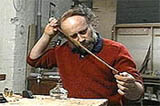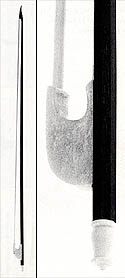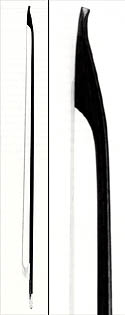
| Opus 50 - Baroque Violin Bow |
|
|
The nut and adjusting screw on this baroque violin bow, which is based on an eighteenth-century French model, are made of fossilized walrus ivory. Designed to play a gut-string baroque violin, the bow weighs forty-eight grams.
The nut and adjusting screw on this pike-head bow, based on a seventeenth-century French model, are made of fossilized walrus ivory; the fluted stick is made of snakewood. The bow, which weighs seventy-six grams, was designed for Opus to accompany Ray Nurse's viola da gamba (Opus 49). 
Louis Bégin Montreal, Quebec 1992 While studying the viola da gamba at the Conservatoire royal de Bruxelles, Louis Bégin took woodworking courses to help him relax. His subsequent fascination with blending wood and music eventually led him to bow making. He completed this stay in Europe with a first prize in viola da gamba performance and with several training sessions in bow making to his credit, including a course given by bow maker Gilles Duhaut in Mirecourt, France. Bégin opened his workshop in Montreal in 1981, dividing his time between bow making and teaching the viola da gamba; he has also frequently performed with early-music ensembles. Bégin has returned to Europe a few times to study major collections in instrument museums. Since 1988, he has worked exclusively at bow making. Louis Bégin's baroque and modern bows are sold in Canada and exported mainly to the United States, France, Germany and Japan.
|
 |



